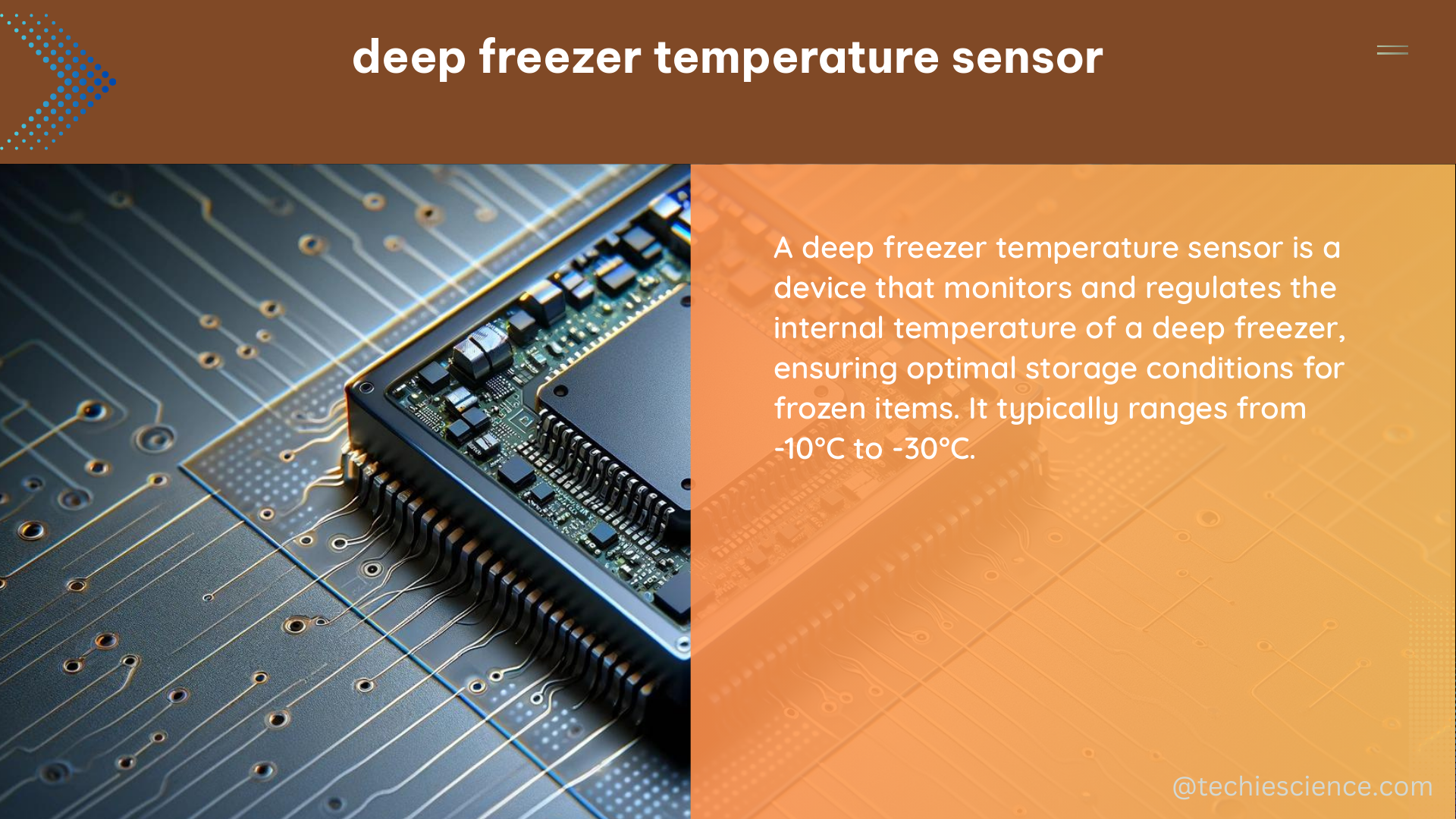Deep freezer temperature sensors play a crucial role in monitoring and maintaining the optimal temperature for preserving perishable items. These sensors provide measurable and quantifiable data, ensuring that the freezer maintains the required temperature range. This comprehensive guide will delve into the key aspects of deep freezer temperature sensors, equipping you with the knowledge to make informed decisions and ensure the proper functioning of your deep freezer.
Temperature Range and Accuracy
Deep freezer temperature sensors should be capable of measuring temperatures as low as -30°C to -40°C, which is the typical temperature range for deep freezers. The sensors must be highly accurate, with a tolerance of ±0.5°C or better, to ensure precise temperature monitoring and control.
For example, the Sensirion SHT85 temperature and humidity sensor can measure temperatures from -40°C to +125°C with an accuracy of ±0.1°C, making it a suitable choice for deep freezer applications. Similarly, the Maxim Integrated DS18B20 digital thermometer can operate in the -55°C to +125°C range with an accuracy of ±0.5°C.
Wireless Connectivity and Battery Life

Wireless temperature sensors are preferred for deep freezers, as they offer flexibility in placement and reduce the need for complex wiring. These sensors typically use Bluetooth, Wi-Fi, or proprietary wireless protocols to transmit data to a central hub or cloud-based platform.
When selecting a wireless deep freezer temperature sensor, it’s crucial to consider the battery life. Sensors should have a long battery life, often ranging from 1 to 5 years, as they are frequently placed in inaccessible locations within the freezer. Rechargeable batteries can be a cost-effective solution, allowing for easy maintenance and replacement.
For example, the Testo Saveris 2 wireless temperature and humidity monitoring system offers sensors with a battery life of up to 8 years, ensuring reliable performance in deep freezer environments.
Data Analysis and Reporting
Easy-to-use data analysis tools are essential for monitoring temperature trends and identifying potential issues. A unified web dashboard or mobile app can help users access and interpret data from various devices, providing a comprehensive view of freezer conditions.
Customizable reporting features are crucial for compliance with health codes and specific business needs. Platforms that offer mean kinetic temperature (MKT) calculations and historical alert logs provide a more detailed understanding of freezer performance.
The Dickson TK550 wireless temperature and humidity data logger, for instance, offers a web-based platform that displays real-time data, generates custom reports, and calculates MKT for regulatory compliance.
Timely Alerts and Notifications
Temperature sensors should provide real-time alerts when temperature fluctuations occur, allowing users to take immediate action to prevent inventory loss. Alerts can be delivered via email, SMS, or push notifications, ensuring that users are promptly notified of any issues.
Some advanced deep freezer temperature sensors, such as the Monnit ALTA Wireless Freezer Temperature Sensor, can be configured to send alerts based on user-defined temperature thresholds, ensuring that critical temperature deviations are immediately addressed.
Condensation Protection and Durability
Sensors should be placed in ziplock bags or other protective coverings to prevent condensation and humidity damage, which can compromise the sensor’s functionality and accuracy. The sensor housing should also be designed to withstand the harsh conditions of a deep freezer environment, including exposure to low temperatures, vibrations, and potential impacts.
The Onset HOBO MX1101 Bluetooth Low Energy Temperature Data Logger, for example, features a rugged, water-resistant housing that can withstand temperatures as low as -40°C, making it suitable for deep freezer applications.
Integration with Home Automation Systems
Deep freezer temperature sensors should be compatible with home automation systems, enabling users to monitor and control freezer temperatures remotely. This integration allows for seamless monitoring and management of the freezer, even when the user is away from the physical location.
The Sensative Strips Zwave+ temperature and humidity sensor, for instance, can be integrated with various home automation platforms, such as SmartThings, Home Assistant, and Hubitat, providing users with a centralized interface to monitor and manage their deep freezer.
Conclusion
Deep freezer temperature sensors are essential for maintaining the optimal conditions for preserving perishable items. By understanding the key features and considerations, you can select the right sensor for your deep freezer and ensure the long-term preservation of your valuable inventory. Remember to prioritize temperature range, wireless connectivity, data analysis, timely alerts, condensation protection, and integration with home automation systems when choosing a deep freezer temperature sensor.
References
- Hubitat Community – Freezer Temp Sensor
- Disruptive Technologies – How to Measure Temperature in Freezers, Fridges, and Cold Storage
- Glacier Grid – Freezer Temperature Sensors Features
- NCBI – Monitoring Temperature in Vaccine Cold Chains: Different Approaches to the Study of Temperature Excursions in Vaccine Shipments
- Reddit – What does everyone use for deep freezer temp?
- Sensirion – SHT85 Temperature and Humidity Sensor
- Maxim Integrated – DS18B20 Digital Thermometer
- Testo – Saveris 2 Wireless Temperature and Humidity Monitoring System
- Dickson – TK550 Wireless Temperature and Humidity Data Logger
- Monnit – ALTA Wireless Freezer Temperature Sensor
- Onset – HOBO MX1101 Bluetooth Low Energy Temperature Data Logger
- Sensative – Strips Zwave+ Temperature and Humidity Sensor

The lambdageeks.com Core SME Team is a group of experienced subject matter experts from diverse scientific and technical fields including Physics, Chemistry, Technology,Electronics & Electrical Engineering, Automotive, Mechanical Engineering. Our team collaborates to create high-quality, well-researched articles on a wide range of science and technology topics for the lambdageeks.com website.
All Our Senior SME are having more than 7 Years of experience in the respective fields . They are either Working Industry Professionals or assocaited With different Universities. Refer Our Authors Page to get to know About our Core SMEs.